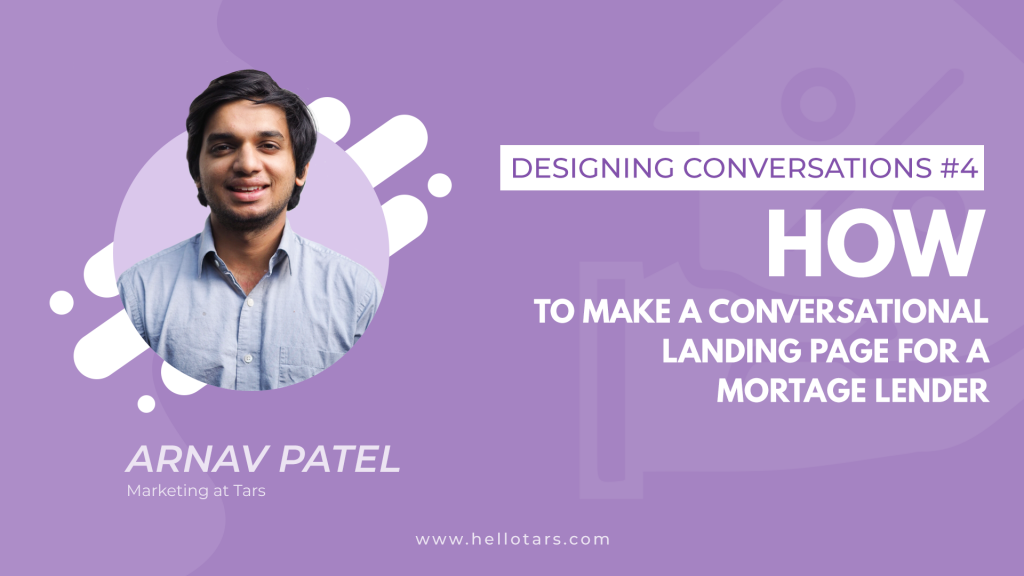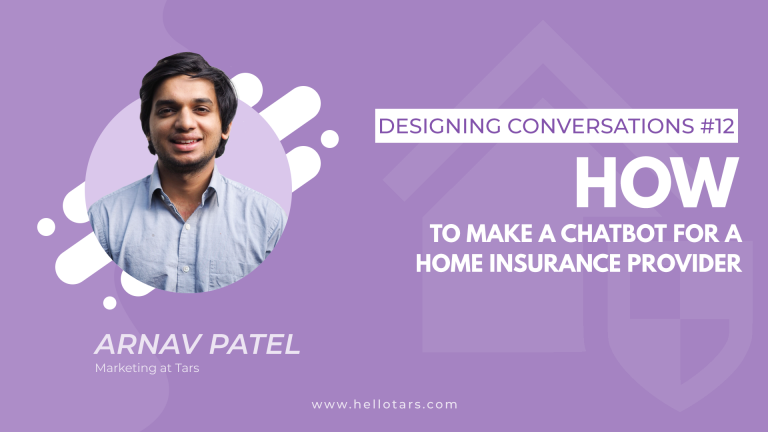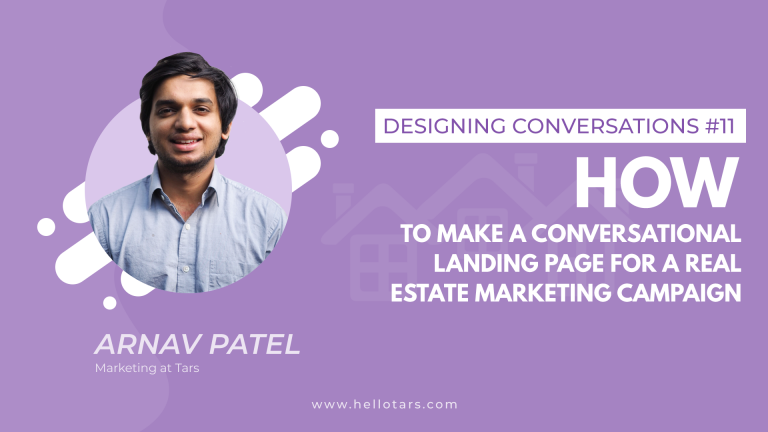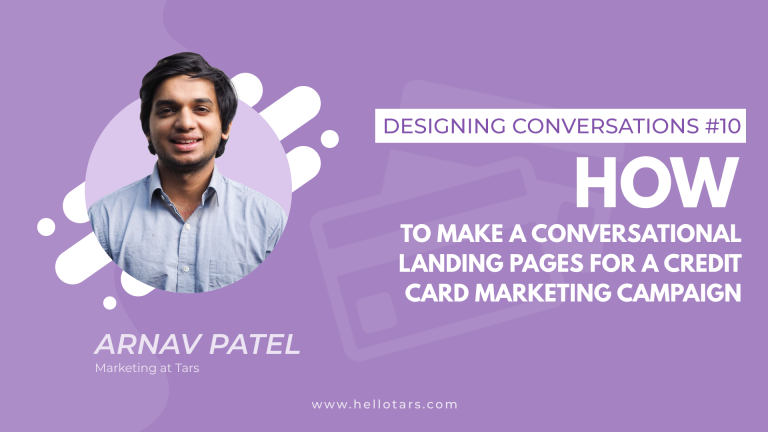[Designing Conversations] How to Make a Conversational Landing Page for a Mortgage Lender

It’s a well-known fact in digital marketing that mortgage lead generation is extremely difficult. Between the intense competition for user mind space, high friction in the application process, and the complexity of the product being sold, mortgage companies have to spend tens of millions of dollars on platforms like Google and Facebook just to get in front of their prospective customers. Within such a marketing environment, it is absolutely imperative to extract the maximum possible value from every dollar of adspend. A well-executed CRO strategy in the space costs little to implement but translates into hundreds of thousands of dollars in saved adspend. Conversational landing pages are one such strategy. Unlike conventional CRO strategies which yield a marginal increase in conversion rate, chatbots can yield a 2-3x increase with minimum effort. Of course, seeing this benefit is wholly contingent on how well marketers can design their conversational experiences. Just like with traditional landing pages, a bad conversational landing page will yield bad marketing results. This guide helps you avoid such an outcome. It is the ultimate resource on conversational landing pages for mortgage marketing and the video below will ensure that you see the conversion rate jump that conversational landing pages can yield.
Landing Page Assessment
The landing page I transformed in this video was found while conducting keyword research on the mortgage industry. It is a pretty basic page from Ally Bank and honestly, the page isn’t all bad.
Pros
The way this landing page handles text is pretty awesome. First of all, there isn’t much text on the page which is always a win, because people hate reading text.
Second, the text that they do have is organized as a numbered list, which is great for the way people actually look at text on a page.
When most marketers think of landing pages they think of a platonic ideal in which prospects land on the page, read all the text and generate a lead. In reality, however, prospects speed read. Their eyes glance over the page picking up whatever they can. Having a numbered list makes this easy, because prospects can read just the numbered headings to get a sense of what’s on the page.
Cons
It’s no secret that we don’t like forms at Tars, but let’s be real, the form on this landing page is truly insane.
Not only does it have 12 fields, which is too much, but it asks for extremely personal details like credit score on the very first screen. This is a big no no in CRO. People aren’t willing to share their personal information until they feel a sense of investment in the lead generation process. In practice, this means getting them onto thte second or third screen before asking for such a detail.
Creating the Conversational Landing Page
Hook
As always we like to begin all our conversational landing pages with a hook. The hook is a set of three messages and a user input option which prospects see as soon as they land on your page.
You can think of this like the first fold of your traditional landing page. It serves the purpose of establishing your branding, capturing user attention and shepherd prospects along the buyer journey. In fact, these three purposes also serve as a template for how your hook should look:
While phrasing these messages keep in mind a few best practices that will ensure the maximum engagement possible:
Add a logo in the welcome message
The welcome message is used to build branding and legitimacy and nothing does this better than a logo. Prospects are accustomed to seeing a logo when they land on a page, and it’s on you to scratch that itch for them
Keep your value proposition message short and singular
Your prospects don’t want to read an essay. They have better shit to do. We recommend keeping the message shorter than a tweet, because that is the length that most modern prospects are willing to read.
Maintain Continuity from User Intent in the Value Prop
In the context of Google Ads especially, you want your page to speak to the problem that prospects are looking to solve (i.e. user intent). If you fail to do this, prospects will drop and go to your competitor’s pages. So if you are bidding on keywords related to interest rate, focus on interest rate in your value prop not bad credit.
Make your ask uncontroversial
Goes back to what I was saying about the credit score question. Prospects don’t want to share personal info right off the bat. You need to get them invested before you can do so. This is why we recommend making the first ask uncontroversial. In the Ally Conversational Landing Page I ask whether they want a free quote and give them a “Get a FREE Quote” button. Hitting the button doesn’t affect the prospect in any way. They haven’t given up any personal info and they can close out if they want to on the next question. But, it gets them to start the conversation and that makes them feel more invested in the conversation.
Use a button input
Related to the previous point, make the input UI in the first gambit a button option. This point comes down to simple math. Think about the credit score question again. Even if you ignore the fact that this is a way too personal question to ask, it takes 4 taps (3 for the credit score and 1 to hit send) to input a credit score into a chat. It takes just 1 tap to respond with a button response. Each tap is an opportunity to drop, so a button input offers less opportunity to drop.
Lead Generation Flow
Asking for user input through a chat is very different than asking for it through a form. Where forms are one-way interactions that a prospect completes on their own and all in one go, a chat is a two-way, back-and-forth interaction between two parties (the prospect and the bot). This transformation results in a higher conversion rate because (1) prospects aren’t confronted with a wall of form fields immediately and (2) because prospects appreciate the intangible value of having a personal interaction over an impersonal form. But, to see these benefits you need to execute well, and there are two best practices to keep in mind when trying to achieve this:
Acknowledge User Input
A conversational lead gen flow is bound by the etiquette of human chat and of human customer service. This means that when a prospect gives you a detail, acknowledge that you received it before asking for the next detail. If a prospect gives you their name, say nice to meet you [their name].
Ask for contact info at the end of the conversation
Asking for email or phone number at the beginning of the conversation comes off as being super salesy and no one likes salesy pitches. Instead ask for the details that are important to the prospect and then ask for contact info. One of our clients ran a test on this and it increased their conversion rate.
Design
This gets back to what I was saying about the welcome message. Branding makes for a more legitimate looking page and a better user experience. In a chat interface, the best way to achieve this is to match the message bubble colors with the brand colors. If there is one primary brand color use that for both bot and user message bubbles and if there are two use the primary color for the bot messages and the secondary color for the user message bubbles.
Arnav is the Director of Content Marketing at Tars. He spends most days building bots, writing about conversational design and scrolling through Giphy’s trending section looking for the gifs that go into the Tars Newsletter.
Recommended Reading: Check Out Our Favorite Blog Posts!

[Designing Conversations] How to Make a Chatbot for a Home Insurance Provider

[Designing Conversations] How to Make a Chatbot for a Real Estate Marketing Campaign

[Designing Conversations] How to Make a Conversational Landing Page for a Credit Card Marketing Campaign

Our journey in a few numbers
With Tars you can build Conversational AI Agents that truly understand your needs and create intelligent conversations.
years in the conversational AI space
global brands have worked with us
customer conversations automated
countries with deployed AI Agents




